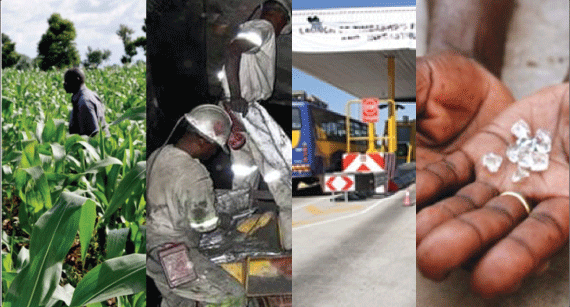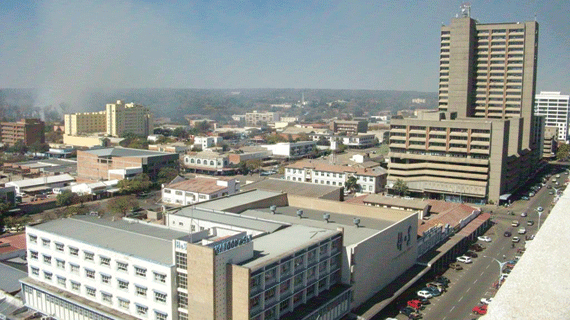
Chapter 2
- Situational Analysis
- Zimbabwe is endowed with natural resources that are in abundance and these include rich mineral deposits, arable tracks of land, flora and fauna, abundant sunlight and water.
- Furthermore, one of the resources that gives Zimbabwe a comparative advantage over regional and other international countries is its economic complexity, that includes the strong human resource base, which is an outcome of a deliberate educational policy instituted by the Zanu PF government at Independence in 1980.
- Zimbabwe’s economic complexity as defined in the Atlas of Economic Complexity, Mapping Paths to Prosperity, reflects the immense social accumulation of knowledge that has been embedded in the socioeconomic ecosystem and productive structures of its economy. This may explain the resilience of the economy in the face of the debilitating illegal economic sanctions. Given the knowledge base and productive resource endowment of Zimbabwe, the country is projected to be a growth leader in sub-Saharan Africa towards 2020.
- Fundamentally, the effective and efficient utilisation and exploitation of these comparative advantages places Zimbabwe on a pedestal for robust economic growth, development and prosperity as well as social cohesion.
- Zimbabwe experienced a deteriorating economic and social environment since 2000 that was caused by illegal economic sanctions imposed by the Western countries. This resulted in a deep economic and social crisis characterised by a hyperinflationary environment, industrial capacity utilisation of below 10% and an overall cumulative gross domestic product (GDP) decline of 50% by 2008.
- In the social sector, health and education were also adversely affected with people succumbing to cholera and other epidemic diseases, while the quality of education was compromised, as evidenced by the growing number of school dropouts and low pass rates in primary and secondary levels.
- Agricultural production was also severely affected, resulting in the country depending on import s to meet the demand for domestic consumption and industrial needs. Furthermore, these challenges led to significant skills flight and erosion of private and public financing, thereby negatively affecting quality service delivery and achievement of the United Nations (UN) Millennium Development Goals.
- The cocktail of measures that were adopted by the government in 2009 resulted in some modicum of economic stabilisation, with Zimbabwe achieving a real GDP growth rate of 5,4% in 2009, 11,4 % in 2010, reaching a peak of 11,9% in 2011.
However, the recovery remained fragile as growth declined from 11,9% in 2011 to 10,6% in 2012 and 3,4% in 2013.
- Despite the economy having shown some degree of stabilisation, with inflation modestly below 5%, it still experiences a myriad of challenges, which if not addressed, will reverse the marginal gains recorded so far.
- The manufacturing sector remains in crisis with capacity utilisation declining from an average of 57% in 2011, 44% in 2012 and 39% in the third quarter of 2013.
This is attributable to structural and infrastructural bottlenecks such as erratic power supply, obsolete machinery and dilapidated infrastructure as well as lack of and high cost of capital, hence negatively affecting value addition and beneficiation as well as employment creation.
- Fiscal space remains severely constrained due to poor performance of revenue inflows against the background of rising recurrent expenditures and a shrinking tax base. The economy has also been saddled with a high debt overhang with an estimated debt stock of $10 billion as at December 2012 caused by the country’s failure to access international capital and investment inflows as illegal economic sanctions have not been removed.
- The agricultural sector, being the backbone of the economy underpinning economic growth, food security and poverty eradication, continues to experience severe systemic challenges within its entire value chain ranging from lack of agricultural financing to lack of affordable inputs. This has also been exacerbated by prolonged periods of drought caused by climatic changes.
- The mining sector continues to be a major foreign currency earner and has potential to become the pillar for economic growth through value addition and beneficiation.
However, the sector continues to be constrained by energy and transport infrastructure challenges, depressed international mineral prices and shortage of utilities among other factors.
- Tourism has, as a sector, demonstrated tremendous potential, particularly benefiting from the successful co-hosting of the 20th Session of the United Nations World Tourism Organisation general assembly by Zimbabwe and Zambia. The sector however, still faces some challenges, key among them, perceived country risk, poor connectivity of local destinations and absence of a revolving fund to support the hospitality industry, especially SMEs and Co-operatives in tourism.
- In the social sector, some measure of progress was achieved on MDG 6 on Combating HIV and Aids, Malaria and Other Diseases; and MDG 2 on Achieving Universal Primary Education, among others. However, the health delivery system continues to be adversely affected by sporadic outbreaks of epidemics such as typhoid and dysentery, increased maternal mortality, shortage of funds to procure essential drugs and equipment and to rehabilitate dilapidated infrastructure.
- On the housing front, the country faces a huge backlog estimated at 1,25 million units due to rising housing demand in urban and resettled areas as a consequence of the Land Reform Programme.
- While the nation prides itself with a literacy rate of 92%, there is need to ensure that schools are built and equipped particularly in the new resettlement areas. The sector still faces a challenge of a curriculum that does not match the developmental needs of the country. The Nziramasanga Commission of Inquiry’s recommendations in this respect should be fully implemented.
- As for water, sanitation and hygiene, high levels of pollution continue to affect urban drinking water. In rural and farming communities, some of the sources of clean water such as boreholes are now ageing or are dysfunctional forcing people to utilise unprotected sources of drinking water. Social protection programmes such as the Basic Education Assistance Module have also been heavily affected by limited fiscal space and the liquidity crunch in the economy, hence adversely affecting the welfare of the poor, orphans and vulnerable children.
- The utilities and infrastructure sector has also not been spared, as roads, civil aviation and railway networks across the country have not seen major improvements and modernisation due to shortage of capital and long term investment opportunities.
In the urban areas, capacity challenges exacerbated by the corruption of erstwhile councilors also affected the efficient operation of councils resulting in poor water and sewerage reticulation systems.
- Energy is a key enabler to productivity and socioeconomic development. However, the sector has experienced challenges largely due to dilapidated and obsolete generation equipment and infrastructure as well as inadequate financing and capitalisation and other structural bottlenecks.
- The transport sector continues to face challenges owing to resource constraints, obsolete equipment, corruption, mismanagement, vandalism and absence of a robust corporate governance policy.
- The nexus of economic stabilisation without increased production in key sectors has not helped the situation as unemployment remains high above 50%, thereby requiring Government to implement policies that must turnaround the fortunes of the key productive agricultural, mining, manufacturing and tourism sectors in the near future.
- More immediately the key infrastructural areas of energy and power development, roads, rail, telecommunications, water, and sanitation will require urgent attention. In view of the foregoing, it is imperative for the government to adopt a two phased plan with Quick Wins being implemented between 2013 and 2015, while the second phase covers the period 2016 to 2018.
- Despite Zimbabwe being endowed with abundant natural resources, the country continues to face multiple environmental management challenges that include pollution, poor waste management, deforestation and land degradation, veld fires, poaching and biodiversity loss.
Furthermore, the country is susceptible to perennial floods and droughts caused by climatic changes emanating from global warming. The climatic changes affect the country’s agro-based economy.
Zim Asset to continue tomorrow










